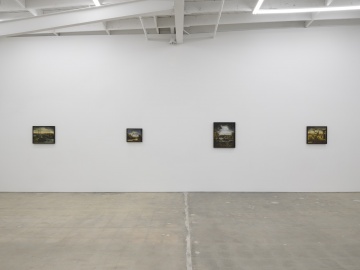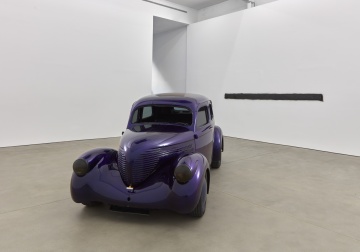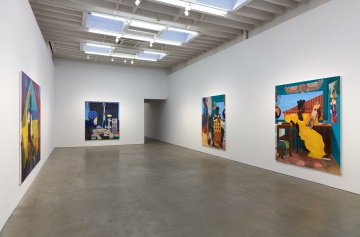Karma
549 West 26th Street
New York, NY 10001
212 717 1671
Also at:
188 East 2nd Street
New York, NY 10009
212 390 8290
22 East 2nd Street
New York, NY 10003
212 390 8290
7351 Santa Monica Boulevard
Los Angeles, CA 90046
310 736 1367
Karma Bookstore
136 East 3rd Street
New York, NY 10009
212 390 9279
New York, NY 10001
212 717 1671
Also at:
188 East 2nd Street
New York, NY 10009
212 390 8290
22 East 2nd Street
New York, NY 10003
212 390 8290
7351 Santa Monica Boulevard
Los Angeles, CA 90046
310 736 1367
Karma Bookstore
136 East 3rd Street
New York, NY 10009
212 390 9279
Founded in 2011 by Brendan Dugan and currently located in NY’s East Village, Karma represents a diverse roster of multi-generational artists. The gallery hosts twenty exhibitions each year, many of which are accompanied by Karma-published monographs and artist books. In 2018, Karma opened its standalone bookstore that presents artist books and rare ephemera alongside the gallery's publications.
Works by the gallery’s artists are featured in numerous public collections including the Metropolitan Museum of Art, New York; Smithsonian American Art Museum, Washington D.C.; Stedelijk Museum Amsterdam; and Hammer Museum, Los Angeles, among others. In addition to its two gallery spaces, Karma’s third gallery location opened in the summer of 2021.
Artists Represented:
Gertrude Abercrombie
Henni Alftan
Alvaro Barrington
Dike Blair
Will Boone
Peter Bradley
Mathew Cerletty
Andrew Cranston
Ann Craven
Verne Dawson
Jane Dickson
Robert Duran
Louise Fishman
Mark Flood
Marley Freeman
Jeremy Frey
Sanaa Gateja
Robert Grosvenor
Peter Halley
Reggie Burrows Hodges
Ulala Imai
Paul Lee
Keith Mayerson
Paul Mogensen
Thaddeus Mosley
Nathaniel Oliver
Woody De Othello
Nicolas Party
Maja Ruznic
Kathleen Ryan
Alan Saret
Arthur Simms
Tabboo!
Mungo Thomson
Ouattara Watts
Xiao Jiang
Manoucher Yektai
Works Available By:
Gertrude Abercrombie
Henni Alftan
Alvaro Barrington
Dike Blair
Will Boone
Peter Bradley
Mathew Cerletty
Andrew Cranston
Ann Craven
Verne Dawson
Jane Dickson
Robert Duran
Louise Fishman
Mark Flood
Marley Freeman
Jeremy Frey
Sanaa Gateja
Robert Grosvenor
Peter Halley
Reggie Burrows Hodges
Ulala Imai
Paul Lee
Hughie Lee-Smith
Keith Mayerson
Paul Mogensen
Thaddeus Mosley
Nathaniel Oliver
Woody De Othello
Nicolas Party
Maja Ruznic
Kathleen Ryan
Alan Saret
Arthur Simms
Tabboo!
Mungo Thomson
Ouattara Watts
Matthew Wong
Xiao Jiang
Manoucher Yektai
Luigi Zuccheri
January 19, 2024 - March 16, 2024
Karma presents an exhibition of paintings by Luigi Zuccheri, open from January 19 to March 16 at 7351 Santa Monica Boulevard, Los Angeles.
Zuccheri’s postwar depictions of rural Northern Italy are at once faithful to naturalistic study and enchanted by an uncanny relationship to scale. The creatures that are the primary subjects of his egg tempera on wood panels have reclaimed the landscape from its flawed human occupants. A brush with Surrealism, an interest in Renaissance ex-voto tablets, and the influence of Metaphysical artists including his friend Giorgio de Chirico inform the paintings on display here. Though Zuccheri had several significant exhibitions in Italy during his lifetime—he was included in the 25th Venice Biennale and had regular solo shows at prestigious galleries in Turin and Milan—this presentation of works made between 1950 and 1955 constitutes the first exhibition of the Italian artist’s work in the United States.
Most fundamental to these lush scenes, however, was the artist’s experience resisting Nazi occupation in Friuli-Venezia Giulia and his resulting status as a fugitive during the final years of World War II. In the conflict’s aftermath, Zuccheri first found consolation in Catholicism, painting ex-votos (devotional works) on the walls of his home and illustrating the writings of saints Francis and Catherine. He soon returned to painting the natural world—a subject he had explored since his late teens. In order to better understand his nonhuman subjects, the artist became an amateur zoologist, exploring the two-hundred-square-mile Venetian Lagoon and its islands in a small sailboat and capturing specimens from which he painted and then returned to their environment.
The early 1950s, however, marked a surreal shift in scale. Using spirited-yet-careful brushstrokes redolent of post-Impressionism, Zuccheri depicted these mammals, amphibians, fish, and insects with rigorous attention to their anatomy and characteristic markings—but their odd proportions within the landscape undermine his studied realism. In one panel (all works untitled, ca. 1950–55), swaths of tempera create a barren landscape of rich umbers into which Zuccheri paints a walnut in between a mouse and a man of nearly equal stature; it is as if the artist has increased the size of the rodent so that he might precisely capture its glinting eyes, fixed on its prized nut, and round ears. The man, in contrast, has no discernable face.
During this period of artistic maturation, Zuccheri gave up the relatively modern practice of oil painting for the ancient medium of egg tempera, studying its techniques in fifteenth and sixteenth century books. By developing his own recipe for the medium, the artist was able to precisely control pigment density, paint thickness, and finish. Though tempera dries quickly and does not lend itself to smooth transitions between hues, Zuccheri embraced its distinctive formal qualities. To render the hare in the foreground of one painting, for example, the artist used a loose, almost Impressionistic cross-hatching technique to blend color. While all of his surfaces are matte, and often feature sections of densely built-up pigment, each retains an ethereal quality that is especially evident in the layers of glaze that constitute his depictions of billowing clouds opening to reveal luminous expanses of sky. Zuccheri’s attachment to the land is evident, too, in his palette—his distinctly muted, sepia-like tones resulted from his practice of grinding his own pigments from stones collected from local shorelines.
These works attest to his attunement to the forms of life that persist even as humans perpetrate violence against their own species. Zuccheri’s larger-than-life animals reveal his desire for nature to retake a landscape tainted by the social machinations of fascism. His scenes are depicted from the perspective of their creatural inhabitants, rather than those who seek to tame and exploit them. In one painting, a peasant trundles through the middleground, seemingly oblivious to the snake, beetle, and mushrooms that populate the fore. In another, slate-gray clouds part as if by some divine intervention to reveal a bright, clear sky that reflects in shimmering strokes on the lake and banks below it. A diminutive figure bends down to peer into the glassy water while another prepares to fish. In the composition’s bottom register, turtles and fish evade the threat of the hook’s snag as they move through the waves, undisturbed.
Ouattara Watts
January 19, 2024 - March 16, 2024
Karma presents an exhibition of new paintings by Ouattara Watts, open from January 19 to March 16 at 7351 Santa Monica Boulevard, Los Angeles.
Over the course of nearly four decades and across three continents, Abidjan-born, New York–based artist Ouattara Watts has developed a painting practice that places cosmograms, numerals, cloth, and other symbols and relics from around the world into relation with each other, leveling hierarchies and creating new relations in the process. Alongside traditional media like acrylic and gouache, the artist embeds materials from a kaleidoscopic range of sources in his monumental, densely layered canvases: papier-mâché, fallen leaves, textiles gleaned from flea markets, and photographic reproductions, among others. The large-scale paintings on view here, all made in the last year in Watts’s Brooklyn studio, comprise the artist’s first-ever exhibition in Los Angeles.
As curator and scholar Okwui Enwezor, a champion of his work, wrote twenty years ago of the “postcolonial constellation” conjured by Watts in his canvases, the artist’s world is one of “discontinuous, aleatory forms, creolization, [and] hybridization . . . with a specific cosmopolitan accent.” The content of his work often gestures at his dual educations—as a young man in Côte d’Ivoire, the artist received an initiation into the animist religion of the Senufo people of West Africa; he later moved to Paris to study at L’École Nationale Supérieure des Beaux-Arts, where he began what would become a longstanding fascination with the Parisian modernists, particularly Pablo Picasso. Like Jean-Michel Basquiat, whom he met and befriended in 1988, Watts inserts his intricate, cipher-like forms into brilliant fields of color. The concept of fractality is foundational for the artist: fractal shapes, common to life forms across time and space, contain reduced-size copies of themselves within their structure, speaking to particularity and universality at the same time. Discussing his practice, Watts explains: “I think universally. . . about the history of the human soul. It’s not a history of clans, ethnic groups, or even artists, it’s what we can call the human condition.”
Watts alternates between working on the wall and the floor. Since the late 1990s, he has utilized drop cloths stained with acrylic as substrates for new paintings. Black and red marks stamped by the paint-covered treads of the artist’s shoes give Spiritual Gangster 02 an allover patterning reminiscent of Jackson Pollock, whose Number 1A, 1948 (1948) features his own handprint as autograph, and the broader legacy of Abstract Expressionism, one of many art-historical movements informing Watts’s painterly vernacular. These indexical traces suggest motion or tempo, evoking Watts’s abiding passion for music, which plays constantly in the studio and deeply influences his practice—like his paintings, music communicates universally while remaining a manifestation of a specific culture (or cultures).
Spiritual Gangster 01, which also features a background stained with splashes of paint, was inspired in part by sigui, a festival held once every six decades by the Dogon people of West Africa to honor the emergence of a new generation. The architectural and mask-like forms in this work tie directly to this practice. During sigui, which takes place when the star Sirius appears between two mountains, a select group of young men are secluded from the rest of the tribe, taught Sigi So, a secret dialect, and entrusted with the Great Mask, a meters-long, carved-wood object that serves as a ritual altar. Like Sigi So, Watts’s oeuvre speaks to the eternally renewing nature of existence in a mysterious language all its own.
Robert Grosvenor
January 6, 2024 - March 2, 2024
Karma presents an exhibition of two new works by Robert Grosvenor, on view from January 6 to March 2 at 22 East 2nd Street, New York.
Horizontality defines much of Grosvenor’s enigmatic, five-decade-long oeuvre. At Karma, two materially distinct artworks, united in their horizontal orientation, share one gallery. A twelve-foot-long board, screwed laterally into the west wall at eye level, is obscured by a cloud of black spray paint. A low-slung, modified readymade occupies the center of the space. Together, they provoke a consideration of the relationship between the upright human body and these recumbent forms that nonetheless float above the ground.
Coated in deep-purple automobile paint, the central sculpture reflects its viewers in its gleaming surface. Where one expects a windshield, there is only open space. The hubcaps and headlights, like the wall sculpture, have been spray-painted matte black. A pair of vintage driving goggles are slung over the steering wheel, and a key decorated with a rabbit’s foot keychain dangles from in the ignition. These details push the otherwise objective sculpture to the edge of a narrative realm, implying the presence of a now-absent driver.
The second work presented here reprises a formal idiom Grosvenor last employed in 1970. A long, thin wooden beam hangs horizontally, activating the gallery’s architecture through linear extension. Its treatment with black paint, sprayed directly onto the wall, highlights the texture of the wood, creating a strong contrast with the pristine, industrial surface of the other work. From a distance, the board’s linear outline disappears into a diffuse cloud; up close, it reappears. As Hal Foster wrote of Grosvenor’s work in 1981, “its effect is one of sheer materialism, of a work of art absolutely given.”
Over years of consideration, Grosvenor discerns and executes subtle adjustments that transform objects into artworks. Augmenting readymades is a means of maximizing their formal appeal, a way to, in his words, “make things better.” His lifelong fascination with vehicles has recently developed into a sculptural practice: a modified speedboat, stripped of motor and steering wheel and treated with turquoise oil paint; a red scooter sited inside of a steel shipping container, the structure’s interior painted gold. By stripping away functionality, the artist places the emphasis entirely on formal relations of scale, material, line, and volume. In contrast with other recent vehicular artworks, this exhibition’s central sculpture is operational, much like his 1969 works Three Wheel Car, the earliest example in his practice of explicitly automotive forms. In each context, the interaction in space between viewer, artwork, and architecture is crucial. This is Karma’s fifth solo exhibition with the artist.
Nathaniel Oliver
My Journey Was Long So Yours Could Be Shorter
January 5, 2024 - March 2, 2024
Karma presents My Journey Was Long So That Yours Could Be Shorter, an exhibition of new paintings by Nathaniel Oliver, on view from January 5 to March 2 at 188 East 2nd Street, New York. This is Oliver’s first solo exhibition with the gallery.
Nathaniel Oliver’s narrative paintings build from our material world, extending into the realm of fantasy. The artist first develops his compositions by sketching from imagination, later adding specific images and objects from all corners of art history and his own life. Like a printmaker, Oliver constructs his paintings from discrete layers of uninterrupted color before adorning them with pattern and texture. His strategy is also one of accumulation—he conflates disparate representational styles, cutting and pasting from an encyclopedia of references, many of which belong to his personal canon of Black painting. Visual citations of West African culture appear—ranging from contemporary Malian textiles, to gris-gris charms from Sierra Leone, to Nigerian ceremonial masks—as do flora and fauna native to the Caribbean, where Oliver’s father was born. His works also foreground oceanic motifs, simultaneously evoking the centrality of the Atlantic to the artist’s upbringing near a wharf in Washington, DC, Homeric epic poetry, and the enduring legacies of the Middle Passage.
My Journey Was Long So That Yours Could Be Shorter points to the personal and societal struggles borne by generations in order to clear new paths for those who come after them. The world in which the exhibition’s paintings take place is parallel to our own, and contains some of its elements, yet remains outside of our timeline. The likenesses of its characters are based on friends and family members whom the artist thinks might suit each role, further confounding fact and fiction. Figures recur across multiple canvases, as if they walked out of one and stumbled into another.
In the dock scene At What Cost, Do I Stay or Go, a silhouetted figure tosses a roll of fairground tickets through the opening of a slightly parted curtain. The drapes, their patterns based on textiles from Mali, are suspended in space, untethered to any architecture of this world. A subway turnstile and a man holding a rooster in one hand and a knife in the other occupy the foreground. Beside them is a marble figure, its body bent deeply backwards, arms in an expressive position modeled on those made by marching band members. At What Cost, Do I Stay or Go is an allegory for the sacrifices necessary to pass from the corporeal world into the spiritual one. Who is granted access to transcendence, and who is denied?
In Would You Believe Me If I Showed You, a regal woman in a canary-yellow gown sits at a desk in front of a large open window that looks out on a terracotta roof top similar to those Oliver encountered while traveling in Lisbon. The artist adapted her pose—seated, in profile, drawing a sea monster on a sketch board—from a Baroque woodcut of the Greek prophetess Sibyl. A plank mask from the Bwa people of Burkina Faso and a painting of a Black knight drawn from a Renaissance altarpiece adorn the room’s walls. Her earrings are cowrie shells, a mollusk husk symbolizing prosperity that was used as currency in Africa for hundreds of years. Like Oliver, the female artist in Would You Believe Me If I Showed You is both a product of numerous cultures and the creator of a world all their own.

 Back to all Member Galleries
Back to all Member Galleries



